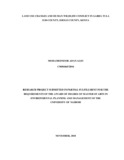| dc.description.abstract | Prevention of human-wildlife conflicts is a top priority of wildlife conservationists in Kenya, especially in regions which are close to wildlife reserves and has high population growth of human being. Human-wildlife conflict incidences have been reported in various part of the county and this had been attributed to land use change and rapid population growth of people which result to encroachment of wildlife habitats. In Garba Tula Sub County threats to biodiversity from rapidly increasing human populations, land sub-division, development projects changing land tenure systems, crop farming, poaching and the blockage of wildlife migratory corridors have been on the increase in the recent past. In addition, Garba Tula Sub County is characterized by unregulated influx of livestock, increased agriculture activities, timber harvesting and sand collection. This study therefore sought to assess whether land use changes were responsible for human wildlife conflict, determine whether population increase has led to human wildlife conflict and assess whether pastoralism causes human wildlife conflict in Isiolo County. The study employed the use of descriptive research design. The target population of this study was 2177 household heads in Garba Tula Sub County. This study used simple random sampling technique to select 326 household heads. The study used both primary and secondary data. Secondary data was obtained from conservancy reports and annual reports. This study used semi-structured questionnaires and key informant interview guides. The research instruments generated both qualitative and quantitative data. Qualitative data from the key informant interview guides and open ended questionnaires in the questionnaires was analyzed by use of thematic analysis. Quantitative data was analyzed by use of both descriptive and inferential statistics. Descriptive statistics comprised of frequencies, percentages, mean and standard deviation. Inferential statistics such as correlation analysis and regression analysis were used to test the research hypothesis. The study found that the relationship between land use changes and human wildlife conflict in Isiolo County was significant (β=0.557, p-value=0.000). Moreover, the study established that there is a positive relationship between population increase and human wildlife conflict in Isiolo County (β=0.745, p-value=0.000). Further, the study found out that there is a positive significant relationship between pastoralism and human wildlife conflict in Isiolo County (β=0.526, p-value=0.000). The study recommends that there is need to have scientifically-based (agroforestry) land use planning and this will be essential in ensuring that the human needs and conservation goals in Garba Tula Sub County are balanced. This can be done by improving the ecological process that is affected by land use. There is need for clear land use planning to counteract possible land resource degradation and ameliorate negative implications of land use mainly human-wildlife conflicts which are currently an issue of concern in the study area. There is also need to raise community awareness so as help in improving understanding and appreciating the wildlife resources thus conserving them. | en_US |



